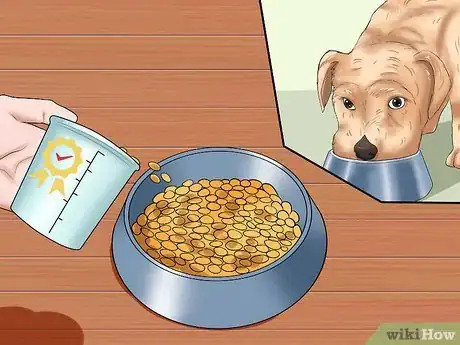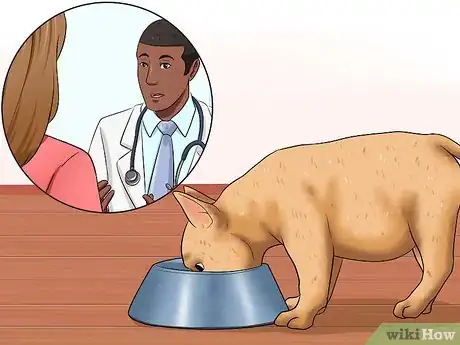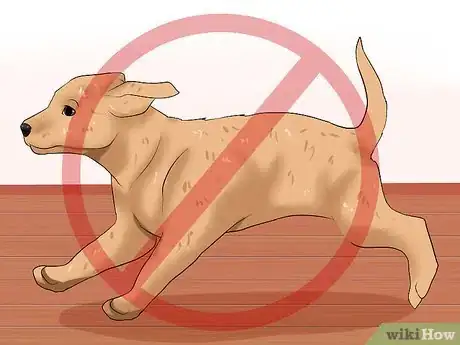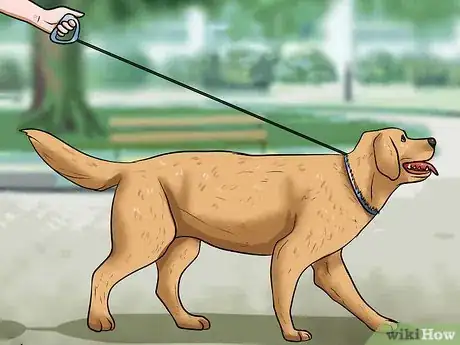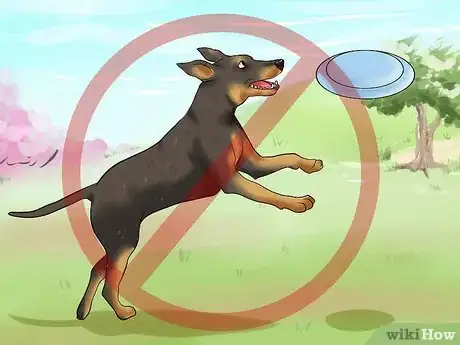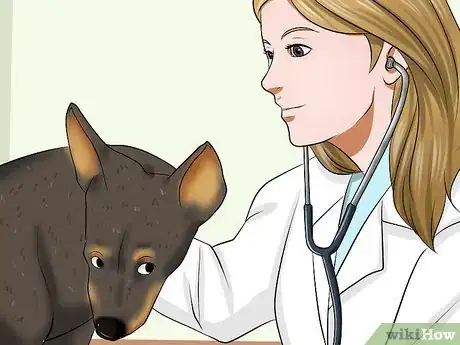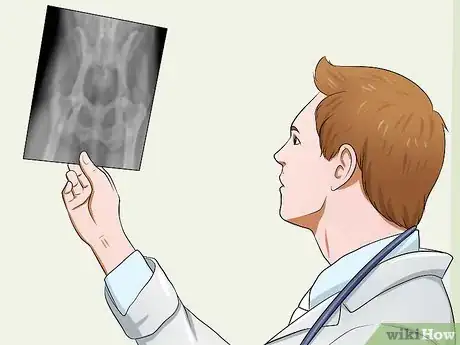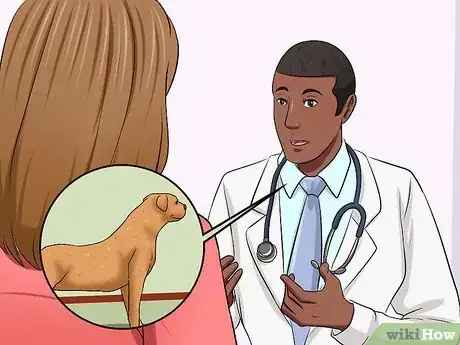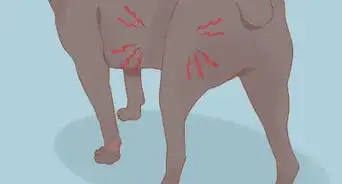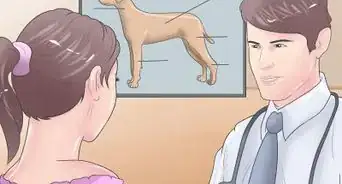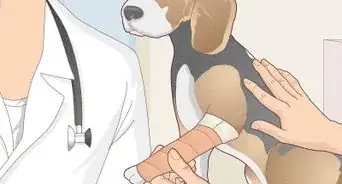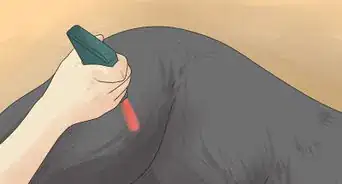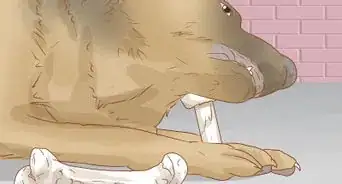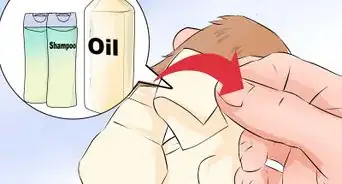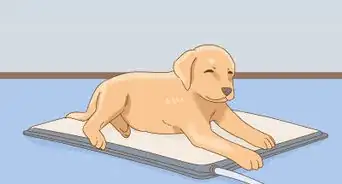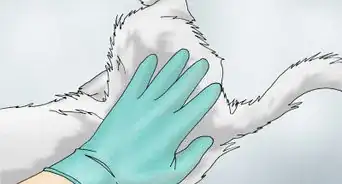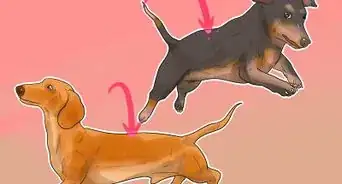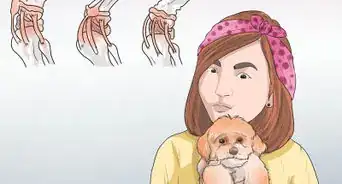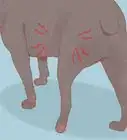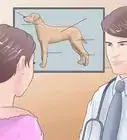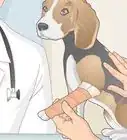This article was co-authored by Pippa Elliott, MRCVS. Dr. Elliott, BVMS, MRCVS is a veterinarian with over 30 years of experience in veterinary surgery and companion animal practice. She graduated from the University of Glasgow in 1987 with a degree in veterinary medicine and surgery. She has worked at the same animal clinic in her hometown for over 20 years.
This article has been viewed 123,285 times.
Hip dysplasia is a common degenerative condition in dogs that occurs when your dog’s hip joint does not form properly. A combination of genetics and other factors can cause the soft tissues surrounding the joint to develop abnormally. This condition can affect any dog, male or female, small, medium, or large sized. However, more than 50 percent of some large breeds, like Bernese Mountain Dogs, Boxers, Chesapeake Bay Retrievers, German Shepherds, and Old English Sheep Dogs, are usually affected and this condition is often less common in smaller dogs. Adjustments to your dog’s weight, care, and exercise routine can help to prevent hip dysplasia from becoming a problem for your pup.
Steps
Feeding Your Dog a Healthy Diet
-
1Give your dog high quality food full of nutrients and minerals. Most vets argue that extra weight on your dog’s frame can lead to stress and pressure on his joints, especially his hip joints. A poor diet, lacking in nutrition, can also lead to poor bone growth and other joint and cartilage abnormalities in puppies and adult dogs. Manage your dog’s weight to prevent obesity and avoid putting unnecessary stress on his joints.[1]
- Look for high quality commercial dog food that is preserved with vitamin E or another natural preservative. These products will have no chemicals and contain high-quality meat instead of meat byproducts. You may have to pay more for higher quality dog food that is full of good sources of protein, carbohydrates, and fat. But it will be worth it if it keeps your dog healthy and ensures he does not end up overweight.[2]
- You should also look at your dog’s current physical state. Does he look bloated or overly round in his middle area? Research has proven that dogs who are kept very lean during their early, puppy years may have a reduced risk of developing hip problems. Keeping your dog thin and active can help prevent any issues associated with obesity.
-
2Consider giving your dog dietary supplements. You should ensure your dog is getting enough vitamins and minerals by giving him antioxidant vitamins C and E. You can also give him Perna supplements. These supplements contain 57 nutrients and are good for strengthening your dog’s joints.
- Speak to your vet about the right supplements for your dog and the proper dosage for each supplement before you give any supplements to your dog. Often, supplements are crushed into your dog’s food so they are easy for him to consume.
Advertisement -
3Talk to your vet if you think your dog may be overweight. Your vet can help you develop a diet for your dog that can help to reduce his weight, or help him keep weight off. Many large breeds are susceptible to overeating, so your vet may be able to offer advice on how to better control your dog’s diet.
- Your dog may also have certain allergies or other conditions that may be causing obesity. Ask your vet to check for other health issues that may be affecting your dog’s weight.
Creating an Exercise Routine
-
1Do not allow your dog to run or leap when he is a puppy. Over-exercising your dog when he is young can lead to bone and joint issues that may lead to the development of hip dysplasia. Gentle, low impact exercises can be beneficial for puppies, but avoid letting your pup run, leap, or jump until he is physically mature.[3]
- High impact sports like jumping and leaping can be hard on your puppy’s developing joints, so avoid doing these activities with your puppy until he is fully developed.
-
2Take your dog on walks or runs when he is an adult. Keep your dog active to help him stay physically fit with moderate exercise like running, walking, and swimming. Dogs with large, strong leg muscle mass may be less likely to develop hip dysplasia than dogs with a smaller muscle mass.[4]
-
3Avoid doing a lot of jumping activities with your dog. Activities that might apply too much force on your dog’s joints, such as jumping for a Frisbee or leaping for a ball, can lead to development of hip issues. Consistent walking, running, and swimming can help your dog build muscle strength without putting too much stress on his body.[5]
Screening Your Dog for Hip Dysplasia
-
1Bring your dog to the vet for testing. Your dog may not show signs of hip dysplasia until he is between four month and one year old. There is a spectrum of symptoms, from no symptoms at all to wobbling, weaving, or an unsteady gait. Your dog may also bunny hop when he runs, or be averse to strenuous exercise or activity.
- If you suspect your dog might have hip dysplasia, it’s best to bring him to your vet for testing. The earlier you get the diagnosis, the sooner you can treat your dog’s condition and help to manage any pain or discomfort he may be experiencing.
-
2Allow your vet to do a physical exam and take x-rays of your dog. Your vet will examine and touch your dog’s hips to feel for any looseness in the joints or any pain reactions from your dog when she flexes or extends his hip joints.
- X-rays will help your vet confirm your dog has hip dysplasia and determine how serious his condition is.
-
3Discuss treatment options with your vet. There are several different surgical procedures available to correct your dog’s hip dysplasia. However, the surgery recommended for your dog will depend on his age, weight, and size. Your vet may recommend two different surgical options:
- Triple Pelvic Osteotomy, which is used on young puppies.
- Total Hip Replacement is recommended for dogs with degenerative arthritis or chronic hip dysplasia.
Expert Q&A
-
QuestionHow much does it cost to fix hip dysplasia in dogs?
 Pippa Elliott, MRCVSDr. Elliott, BVMS, MRCVS is a veterinarian with over 30 years of experience in veterinary surgery and companion animal practice. She graduated from the University of Glasgow in 1987 with a degree in veterinary medicine and surgery. She has worked at the same animal clinic in her hometown for over 20 years.
Pippa Elliott, MRCVSDr. Elliott, BVMS, MRCVS is a veterinarian with over 30 years of experience in veterinary surgery and companion animal practice. She graduated from the University of Glasgow in 1987 with a degree in veterinary medicine and surgery. She has worked at the same animal clinic in her hometown for over 20 years.
Veterinarian The cost varies depending on how severe the problem is and the dog's size. An average cost per month for pain relief can range from $30-120, whilst total hip placement surgery is around $5,000 depending on the dog's size.
The cost varies depending on how severe the problem is and the dog's size. An average cost per month for pain relief can range from $30-120, whilst total hip placement surgery is around $5,000 depending on the dog's size. -
QuestionWhat causes hip dysplasia in dogs?
 Pippa Elliott, MRCVSDr. Elliott, BVMS, MRCVS is a veterinarian with over 30 years of experience in veterinary surgery and companion animal practice. She graduated from the University of Glasgow in 1987 with a degree in veterinary medicine and surgery. She has worked at the same animal clinic in her hometown for over 20 years.
Pippa Elliott, MRCVSDr. Elliott, BVMS, MRCVS is a veterinarian with over 30 years of experience in veterinary surgery and companion animal practice. She graduated from the University of Glasgow in 1987 with a degree in veterinary medicine and surgery. She has worked at the same animal clinic in her hometown for over 20 years.
Veterinarian Hip dysplasia is a 'multifactorial' condition, meaning that many different factors contribute to it. There is a strong hereditary component of parents with poor hips passing their genes onto the pups. Also, too much exercise when soft joints are still growing can cause damage, as can a poor diet.
Hip dysplasia is a 'multifactorial' condition, meaning that many different factors contribute to it. There is a strong hereditary component of parents with poor hips passing their genes onto the pups. Also, too much exercise when soft joints are still growing can cause damage, as can a poor diet. -
QuestionWhat are the signs of hip dysplasia in dogs?
 Pippa Elliott, MRCVSDr. Elliott, BVMS, MRCVS is a veterinarian with over 30 years of experience in veterinary surgery and companion animal practice. She graduated from the University of Glasgow in 1987 with a degree in veterinary medicine and surgery. She has worked at the same animal clinic in her hometown for over 20 years.
Pippa Elliott, MRCVSDr. Elliott, BVMS, MRCVS is a veterinarian with over 30 years of experience in veterinary surgery and companion animal practice. She graduated from the University of Glasgow in 1987 with a degree in veterinary medicine and surgery. She has worked at the same animal clinic in her hometown for over 20 years.
Veterinarian The signs of hip dysplasia are those general signs linked to hind leg lameness. This includes taking steps of an uneven length on the back legs, limping, and difficulty jumping up. However, these are general signs and the pain needs to be localized to the hip which the vet will do during a physical exam.
The signs of hip dysplasia are those general signs linked to hind leg lameness. This includes taking steps of an uneven length on the back legs, limping, and difficulty jumping up. However, these are general signs and the pain needs to be localized to the hip which the vet will do during a physical exam.
References
- ↑ http://www.animalplanet.com/pets/healthy-pets/dog-hip-dysplasia/
- ↑ http://www.cesarsway.com/dog-care/nutrition/choosing-the-right-dog-food
- ↑ https://pets.webmd.com/dogs/canine-hip-dysplasia#1-7
- ↑ http://www.animalplanet.com/pets/healthy-pets/dog-hip-dysplasia/
- ↑ http://www.animalplanet.com/pets/healthy-pets/dog-hip-dysplasia/
About This Article
To prevent hip dysplasia in dogs, keep your dog at a healthy weight by feeding it a high-quality dog food that's full of nutrients and minerals and taking it on regular walks and runs. You can also give your dog dietary supplements so it gets the vitamins it needs to grow healthy bones, but always consult your vet first. Also, avoid activities that require your dog to jump a lot, like playing with a frisbee or leaping for a ball, since it can strain your dog's joints. If your dog is still a puppy, make sure it's not running or leaping a lot since that can lead to bone issues later on. To learn how to screen your dog for hip dysplasia, scroll down!
